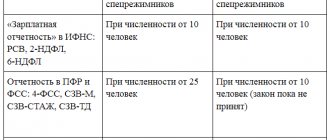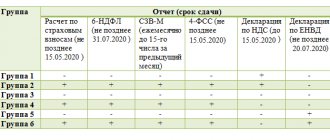Individual entrepreneurs who, after registration, have submitted a notice of transition to a simplified taxation system, are required to report under this regime, even if they do not conduct actual activities. In this case, a zero declaration is submitted under the simplified tax system for 2021 for individual entrepreneurs; in our article you will find a sample filling and reporting form.
How to file a zero tax return
A zero 3-NDFL report is submitted according to the general rules, but with zero indicator values.
It should be submitted even if you did not conduct business this year. Article navigation
- Who must submit a zero declaration and when?
- Composition of zero reporting documents
- Features of a zero declaration under the simplified tax system
- Zero reporting for OSNO
- Filling out a zero VAT return
- Zero declaration of individual entrepreneurs for personal income tax
- Composition of a zero declaration for UTII
- conclusions
All individual entrepreneurs and companies are required to report profits received and taxes paid. The final document is the tax return. If the taxpayer did not conduct commercial activities and there was no movement of funds in his accounts, he submits a zero declaration.
Reporting form
Note! In 2021, a new form of the simplified tax system declaration was approved, but the report for 2020 is still submitted using the old form. The new form is relevant for individual entrepreneurs and LLCs that cease operations after March 20, 2021.
The form of the annual declaration under the simplified tax system for 2021 was approved by order of the Federal Tax Service of Russia dated February 26, 2016 No. ММВ-7-3/ [email protected] and is valid for reporting for the periods from 2015 to March 20, 2021.
If an individual entrepreneur’s zero reporting is submitted using an outdated form, it is considered not submitted. Of course, if you personally submit the report to the inspectorate, they will tell you that the form does not match, but if you sent the declaration by mail, you will assume that it was submitted, although this is not the case.
Before you fill out a zero declaration under the simplified tax system, please note that different tax objects (Income and Income minus expenses) have their own sheets. You only need to fill them out, not the entire form.
| USN Income | USN Income minus expenses |
| Title page | Title page |
| Section 1.1 | Section 1.2 |
| Section 2.1.1 | Section 2.2 |
| Section 2.1.2 (only for those who are registered as a trade tax payer) |
In addition, regardless of the simplified version, entrepreneurs who have received targeted funding fill out section 3.
Who must submit a zero declaration and when?
Entrepreneurs believe that they are not required to report if there are no taxes to pay. But that's not true. Reporting must be provided regardless of whether the activity occurred or not.
By registering a business, a citizen becomes a taxpayer, and the amount of charges is determined based on reports submitted to the relevant services. If the document is not submitted, this does not mean that taxes are canceled. The inspectorate simply cannot determine the amount of deductions and punishes the entrepreneur for violating the law.
In cases where the activity of an enterprise is suspended or not carried out for various reasons, it is necessary to submit a zero declaration. It confirms the fact that there is no profit and that there are no taxes payable. The declaration must be accompanied by a free-form explanation indicating the reasons for the lack of payments.
Filing a zero return is provided for the following taxes:
- VAT – on added value;
- Personal income tax - on the income of an individual, but only if the individual entrepreneur works for OSNO;
- Unified Agricultural Tax (USA) (the first year after state registration);
- for individual entrepreneurs using a simplified taxation system;
- on the profits of organizations.
For all other taxes, you do not need to file a zero return. In the event that the tax base of an entrepreneur, after applying various benefits, turns out to be negligible, the reporting is no longer zero, and he needs to fill out regular tax returns.
A controversial issue is zero reporting on UTII. According to the Tax Code of the Russian Federation, this taxation system does not provide for the submission of a zero declaration, but can be accepted as an exception, for example, in case of temporary loss of ability to work of an individual entrepreneur.
A zero tax report for individual entrepreneurs is submitted if:
- the taxpayer received a state registration certificate, but was not engaged in his activities throughout the entire period before the reporting date;
- economic activity has a pronounced seasonal nature (therefore, during the season of active commercial activity, regular reporting is provided, and in the off-season, when there is no movement of funds in the accounts, it is better to fill out a zero declaration);
- the taxpayer has suspended its activities, but is formally considered an active business entity, having no debts to partners, clients, the state and no movement of funds in its accounts.
A zero return must be submitted to the tax office within the same time frame as reporting with numerical data. The frequency of submission depends on the type of tax chosen by the entrepreneur for conducting business. A zero declaration for an individual entrepreneur working under the simplified tax system is submitted annually before April 30, for a legal entity - until March 31. For VAT and UTII, reporting is submitted quarterly - before the 20th day of the month following the reporting period, for income tax - every quarter until the 28th, for 3-NDFL - once a year until April 30.
Business break for individual entrepreneurs - what we pay for, how we report
There are life situations when a person registered as a private entrepreneur is forced to postpone his business for a while. The reasons may be different: another temporary job, caring for loved ones, the need for personal treatment, or just wanting to relax.
In any case, freezing commercial activities should be done correctly, with a clear understanding of your rights and obligations as a taxpayer. This will avoid many problems, fines and proceedings with tax authorities.
Key questions that arise at this stage:
- should an individual entrepreneur pay taxes and for what;
- what payments does the state exempt non-working entrepreneurs from;
- what fees will be canceled only after the business is completely closed;
- how to report to the tax service and extra-budgetary funds during the period when business activities are not carried out.
If we talk about the mandatory payments of an inactive individual entrepreneur, then you need to know that, even without doing business, an entrepreneur is obliged to make contributions as a self-employed citizen to the Pension Fund of the Russian Federation, as well as to the Compulsory Medical Insurance Fund.
The obligation to pay insurance premiums comes into force from the moment of registration of an individual entrepreneur and ceases only at the moment of official closure of the private business.
Starting from 2021, the procedure for determining the amount of a fixed payment for individual entrepreneurs is changing - now this amount will not be tied to the minimum wage:
- The fixed payment amount for individual entrepreneurs in 2021 for contributions to compulsory health insurance is 5,840 rubles. (Clause 2, Clause 1, Article 430 of the Tax Code of the Russian Federation).
- All individual entrepreneurs, regardless of the amount of income received in 2021, must transfer a contribution to the OPS for themselves in the amount of 26,545 rubles. (Clause 1, Clause 1, Article 430 of the Tax Code of the Russian Federation).
Table: BCC for insurance premiums for individual entrepreneurs from 01/01/2017
| Type of insurance premium | KBK (field 104 payments) |
| Insurance premiums for mandatory insurance in a fixed amount, paid by individual entrepreneurs for themselves to the Federal Tax Service | 182 1 0210 160 |
| Insurance premiums for compulsory medical insurance in a fixed amount, paid by individual entrepreneurs for themselves to the Federal Tax Service | 182 1 0213 160 |
There are some relaxations regarding the suspension of payment of insurance premiums. They directly depend on the reason why the businessman is winding down his business. However, in order to suspend payments to off-budget insurance funds, compelling reasons are needed:
- caring for a child under one and a half years old, a disabled person of the first group or an elderly person over 80 years old;
- inability to conduct business in the region where the entrepreneur lives with his family (for example, military units, abroad);
- conscription service.
If previously, in order to remove the obligation to pay insurance premiums, it was necessary to provide a mass of documents confirming this right, now regulators have abolished this requirement. Nevertheless, the cancellation of contributions will need to be justified by the Pension Fund.
All other entrepreneurs are not exempt from pension fees, as well as contributions to compulsory health insurance.
suspension of insurance payments for individual entrepreneurs is possible, but it requires compelling reasons
As for tax reporting during the period of absence of business activities of an individual entrepreneur, the answer is clear - declarations based on the results of the reporting period must be submitted. This does not depend on the period for which activities are suspended (several months or years). Until the entrepreneur is deleted from the Unified Register of Entrepreneurs (USRIP), this is the main responsibility of the individual entrepreneur.
These requirements are enshrined in Article 289 of the Tax Code of the Russian Federation “Tax Declaration”. It legally establishes that timely submission of tax declaration calculations is the direct responsibility of all individual entrepreneurs, regardless of whether they have to pay taxes or advance payments, whether they are conducting business or are simply registered as entrepreneurs. Each private businessman, after the expiration of the reporting tax period, which is established by the taxation system, must submit declarations for all taxes assigned to this system (and types of individual entrepreneur activities).
The good news is that reporting will be minimal and will not take much time, most likely even less than when justifying grace periods.
The main purpose of providing a zero declaration is to confirm the right of an individual entrepreneur not to pay taxes. A zero declaration can be applied only in cases where the individual entrepreneur did not receive income, did not conduct settlement transactions, that is, there was no movement of funds either in bank accounts or at the cash desk. This fact will be the main justification for temporarily stopping the business.
Zero reporting on business holidays is provided for almost all tax regimes, with the exception of:
- the patent system - because there is simply no reporting on it;
- tax on imputed income - since this is not implied by the taxation system itself, even if you just understand the concepts: tax is imputed on income, there is no income - the system does not work.
For declarants who do not carry out private commercial activities, each tax regime has its own zero declarations.
Declaration of taxes is mandatory even if the individual entrepreneur’s performance indicators are zero.
Composition of zero reporting documents
A zero declaration is a standard reporting document reflecting the absence of activity. There are no special forms for it. They submit zero declarations on the same forms as reporting indicating significant numerical indicators, but their composition may be different, depending on the selected period and the individual entrepreneur taxation system.
Composition of a zero declaration by type of taxation:
| Reporting period | Composition of the declaration |
| A reporting period with quarterly advance payments or a reporting period with quarterly payments with monthly advances. | Title page, subsection 1.1 in the first section of the document. Data is also entered into sheet 2 and appendices No. 1 and 2. |
| Reporting period with monthly payment of advances on profit received from the actual activity. | Title page, subsection 1.1 of the first section, sheet 2. |
| Annual report. | Title page, subsection 1.1 of the first section, sheet 2 and appendices No. 1 and 2. |
To ensure that all data is entered fully and correctly, you should use a zero declaration form for individual entrepreneurs approved by the Federal Tax Service. Orders of the Federal Tax Service establish both sample declarations and rules for filling them out.
When preparing a document:
- the text must be written in black, blue or purple ink only;
- the data in the declaration must be written in capital block letters (when filling out the document electronically, Courier New font size 16-18 is used);
- there should be no errors, corrections or blots;
- letters and numbers are entered one in each cell, words are separated from each other by an empty cell;
- amounts are indicated only in rubles, that is, without kopecks (rounding is carried out according to the rules of mathematics);
- if the amount is zero, a dash is placed in the cells.
The peculiarity of filling out a zero declaration is that most of the data will be missing. The preparation of the document should begin with the title page. To do this correctly, you can see a sample of filling out a zero declaration, for example, on the website of the State Services service.
In the header of the title page you must indicate the TIN and KPP of the entrepreneur, as well as the serial number of the page. The following is information about:
- tax period;
- code and name of the regional representative office of the Federal Tax Service;
- full name of the enterprise (abbreviation should be indicated in brackets);
- OKVED code, according to which the individual entrepreneur operates;
- total number of pages;
- taxpayer - last name, first name, patronymic.
At the end of the sheet the date of filling out the declaration and the signature of the official are indicated.
In subsection 1.1 of section 1, indicate the TIN, KPP, code according to OKTMO and KBK. All other columns are marked with dashes.
The second sheet of the document contains information about the calculation of tax, but since it cannot exist in the absence of income, only the TIN, KPP, and taxpayer code are indicated.
Additional indicators include tax rates assigned in a specific region. All other fields are filled with dashes.
In the appendices to the second sheet, only three main indicators should be entered - TIN, KPP, taxpayer code. In addition, Appendix No. 2 indicates the method of calculating depreciation for a specific enterprise. All other lines are marked with dashes.
You can make a zero individual entrepreneur report on the simplified tax system, OSNO or personal income tax using the online service “My Business”. The service automatically generates a document, checks it and sends it electronically.
Features of a zero declaration under the simplified tax system
Individual entrepreneurs operating under a simplified tax system must report under this regime. Since entrepreneurs do not keep accounting records, they do not submit accounting documentation to the Federal Tax Service. Zero reporting of individual entrepreneurs under the simplified tax system in 2021 includes only sheets of the annual declaration.
There is one more advantage for individual entrepreneurs: unlike organizations, they are not automatically recognized as employers, therefore they are registered as an insurer only after concluding an employment contract with employees. If the entrepreneur did not conduct business and did not enter into such an agreement, then he is not an insurer and does not submit reports for employees.
There is no requirement to submit reports regarding the payment of personal insurance premiums. The entrepreneur is only required to make fixed payments for personal health and pension insurance.
In 2021, contributions for pension insurance amount to 29,354 rubles, and for medical insurance – 6,884 rubles.
If at least some funds passed through the bank accounts of the simplified person or through the cash register, it will not be possible to get away with a zero declaration. It will be necessary to submit a standard report with all indicators.
A zero report to the tax office for individual entrepreneurs must be provided at the place of registration. It can be done:
- by contacting the Federal Tax Service in person or using the services of an authorized representative;
- by registered mail;
- using telecommunication channels.
Submission of zero reporting for individual entrepreneurs to the simplified tax system is carried out once a year, no later than April 30, and for legal entities. persons – until March 31. Failure to timely submit a declaration to the Federal Tax Service may result in penalties. The Federal Tax Service has the right to suspend transactions on bank accounts until the report is submitted.
Zero reporting for OSNO
There are a number of taxes that are mandatory for the general regime - these are income tax and VAT. They will have to submit zero declarations even if there is no cash flow. These documents must include a title page and the required dashed sections.
Entrepreneurs using the general taxation system should submit zero declarations:
- for VAT – quarterly, until the 25th day of the month following the tax period;
- for income tax - every quarter, until the 28th day of the month following the reporting period;
- for property tax - quarterly, until the 30th;
- for insurance premiums - quarterly, until the 20th;
- accounting report – once a year, until March 31 of the following year.
In the absence of economic activity, it is allowed to submit a simplified declaration - EUD, which replaces reports on value added and profit taxes. It must be sent to the Federal Tax Service by the twentieth day after the end of the reporting quarter.
The EUD can be submitted to the tax office:
- in electronic form, using software products designed for sending reports;
- in electronic form using a program from the Federal Tax Service (you will need a registered digital signature);
- on paper during a personal visit to the Federal Tax Service;
- on paper via postal mail (valuable letter with a list of attachments).
All VAT reporting should be submitted only electronically. Those who do not pay VAT can submit zero declarations, both electronically and on paper (at the discretion of the respondent). You can fill out an individual entrepreneur’s zero declaration online in any online accounting program. It’s quite convenient to do this in the “My Business” service.
Results
The EUD can be passed if a number of conditions are met. The declaration can replace those taxes for which the reporting period is a quarter or a year. The EUD cannot be non-zero. The procedure for forming a EUD is quite simple, but has several nuances that must be observed. You can take the EUD form, get acquainted with a sample of how to fill it out, and also learn more about the nuances of forming and submitting a declaration on our website.
Sources:
- Tax Code of the Russian Federation
- Order of the Ministry of Finance of Russia dated July 10, 2007 No. 62n
You can find more complete information on the topic in ConsultantPlus. Free trial access to the system for 2 days.
Filling out a zero VAT return
If there are zero indicators of entrepreneurial activity in the declaration, instead of 12 sections, you only need to fill out the title page and the first section.
Filling out the title page:
- TIN – indicates the number issued by the tax service.
- Reporting document adjustment number. If it is submitted for the first time, you should indicate 0. In the case when the declaration has already been submitted for a given reporting period, you must enter 1, 2, etc., depending on what the adjustment is in the account.
- Tax period code. When submitting a report for the first quarter, code 21 is indicated, for the second - 22, for the third - 23, for the fourth - 24.
- Tax authority code. The code of the tax office to which the declaration is submitted is indicated.
- Taxpayer. The full name of the organization is indicated.
- OKVED code.
- Taxpayer's contact telephone number.
- Number of pages.
- Full name of the taxpayer, his signature.
- Date of document creation.
Completing section 1:
- TIN and checkpoint of the organization;
- OKTMO code;
- budget classification code;
- dashes are entered in the cells of all other lines;
- At the end of the document there is a signature and the date of preparation.
Statement of financial results (profit and loss)
Organizations required on OSNO
Sample zero profit and loss statement
example and form of a zero profit and loss statement
For 2015-2019, a new form is in force - filling out a statement of financial results (profit and loss).XLS (Ministry of Finance of the Russian Federation: Order 66n dated 07/02/10 (as amended on 04/06/2015))
See also Simplified Income Statement
Lines in the income statement cannot be removed.
How to fill out a profit and loss report?
Change the values highlighted in red in the declaration to your own. In general, the first page is the same as in the balance sheet.
Taxpayer Identification Number (TIN) and checkpoint: you only need to enter it on the main page; on the rest it will be added automatically.
The OKPO code is assigned at the time of registration of a legal entity and shows the type of activity. The form of ownership (according to OKFS) can be found here. The organizational and legal form (according to OKOPF) is here. Unit of measurement: thousand rubles. — OKEI code 384; million rubles — OKEY code 385. You need 384 as soon as possible.
Deadlines for submitting a zero profit and loss statement
I quarter — until 30.04, II quarter. — until 30.07, III quarter. - until 30.10, IV quarter (annual) - until 30.03
There are no penalties for providing a zero income statement. For delivery not on time - 200 rubles.
Zero declaration of individual entrepreneurs for personal income tax
An entrepreneur engaged in business activities individually, that is, without employees, does not submit personal income tax reports. If people work for him, they are paid a salary. In this case, the individual entrepreneur is required to report on forms 2-NDFL and 6-NDFL.
If employees have never been paid a salary in a calendar year, then the entrepreneur is not a tax agent and does not need to submit empty forms.
If an individual entrepreneur did not conduct business for a year and did not receive income, he should submit a zero 3-NDFL. It includes a title page and sections 1, 2. The 3-NDFL zero declaration must be submitted within the same deadline as the standard one - April 30. It can be provided on paper by appearing in person at the Federal Tax Service, sent by mail, as well as using TKS or through the “Taxpayer Personal Account” on the Federal Tax Service website.
The title page is filled out as usual. Section 1 should reflect the following information:
- Full name of the entrepreneur;
- in line 010 you must indicate code “3”, indicating that the individual entrepreneur does not pay or return tax on this declaration;
- line 020 contains the current BCC provided for personal income tax on income received by individual entrepreneurs - 18210102020011000110;
- line 030 indicates the territory code OKTMO according to Classifier OK 033-2013;
- in lines 040 and 050 you need to enter zero values;
- Signature and date are placed at the bottom of the page.
Composition of a zero declaration for UTII
The main difference between the UTII declaration and the others is that the tax is calculated not on the basis of real indicators received for the quarter, but on the basis of such physical indicators as the area of the sales floor, the number of vehicles, etc. This principle of calculating tax payments does not allow Individual entrepreneurs and companies using UTII must report in the absence of activity with declarations with zero indicators.
The taxpayer will not need to submit a UTII return only if he is deregistered with a tax organization. To do this you need to submit an application. The tax authority, having received such an application from the taxpayer, must send him a notice of deregistration. From the moment the notification is received, the entrepreneur loses the obligation to provide a UTII declaration, but in the time before deregistration he will have to report.
Can a director not receive a salary?
Since mandatory insurance contributions are calculated from wages, the question arises: is the company registered, has one director, but there is no salary? Many organizations in which the founder is a director do not pay wages in the absence of activity.
If claims arise from regulatory authorities, you can refer to the letter of the Ministry of Finance dated 09/07/2009 No. 03-04-07-02/13, which states that if an employment contract has not been concluded with the director, then the responsibilities for calculating wages there is no charge. According to Art. 273 of the Labor Code of the Russian Federation, the sole founder cannot conclude an employment contract with himself. Subsequent payments, subject to profit, will be considered dividends. In addition, the Russian Pension Fund believes that submitting a blank SZV-M report in this case is also not necessary.
However, already in 2021, the opinion of officials changed - see Letter of the Ministry of Labor of Russia dated March 16, 2018 N 17-4/10/B-1846. Now in SZV-M a director without a salary must be submitted to the Pension Fund. Consequently, if the company had only the founder, who is also the director, who did not receive a salary, then until 2021 zero reporting was submitted. Now information about the sole founder-director must be sent to the Pension Fund. Moreover, it makes no difference whether an employment or civil contract has been concluded with him and whether there are wages accrued.
IMPORTANT!
SZV-M for the founder - director without salary must be submitted to the Pension Fund. Also include information about the founder if an employment or civil law contract has not been concluded with him.







